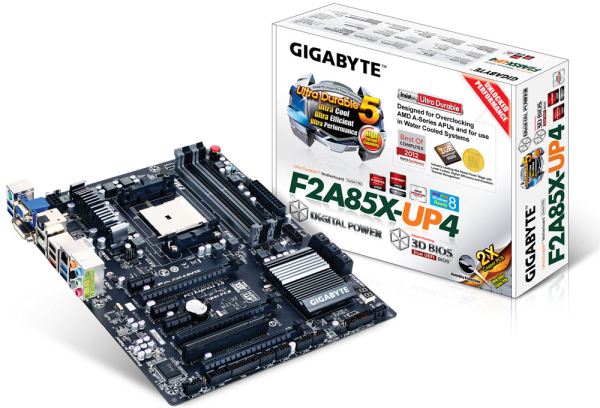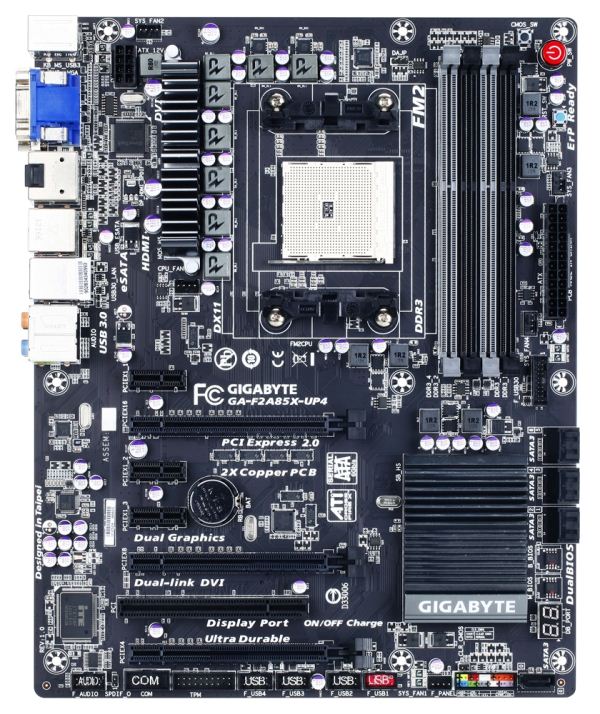Gigabyte F2A85X-UP4 Review – Are PowIRStages Needed with Trinity?
by Ian Cutress on December 14, 2012 12:00 PM EST- Posted in
- Motherboards
- Gigabyte
- FM2
- A85X
During the testing of a motherboard, anything that seems out of the ordinary or is not default behavior compared to a normal usage scenario gets noted down in my lists under the benchmark results. It gives a point of reference for me when it comes to writing the review and tells you guys and gals how I felt about the product. Looking back on my notes now and simply put, there are none. The Gigabyte F2A85X-UP4 just worked out of the box without issues and no abnormal behavior. This is an oddly surreal experience, especially in my line of work.
Working normally is not grounds for an award, I should make that clear. Working normally should be the standard by which all boards are judged – everything should work as intended anyway. To give something an award for ‘working normally’ is to do injustice to an award system and devalue the importance it has on driving innovation. Innovation is a key word in the motherboard industry, and each manufacturer should be trying their hardest to provide something new to the table that no-one else does. Price is also another key word, which ultimately decides the fate on almost everything apart from halo products.
The Gigabyte F2A85X-UP4 is currently on sale for $130 at Newegg, some $10 cheaper than the ASUS F2A85V-Pro high-end model we reviewed, but $20-$25 more expensive than the ASRock FM2A85X Extreme6 and MSI FM2-A85XA-G65 we have also reviewed. For that money, as mentioned previously, we get PowIRStage IR3550 ICs in the power delivery, which are not exactly cheap. Video outputs come via each one of the four major outputs on offer today – D-Sub, DVI-D, HDMI and DisplayPort; audio and network use the Realtek ALC892/8111E combination often sold in bulk and at a discount when purchased together to motherboard manufacturers. The eight SATA 6 Gbps ports of A85X are split such that 7 are on the board as normal SATA ports and one becomes an eSATA – a slightly different tack than the mSATA variations we saw in the Gigabyte Z77 release. Aside from the normal USB ports on board we get an Etron EJ168 USB 3.0 controller for another pair of USB 3.0 on the back panel. Power/Reset buttons and a two-digit debug LED are always welcome.
The Gigabyte eco-system on their main lines of motherboards and chipsets revolve around the 3D-BIOS implementation, which is a way of saying ‘we use an oblique image in our BIOS’. I have critiqued the Gigabyte 3D BIOS system previously, noting its failings, both to our readers and directly to the people at Gigabyte who make these decisions. While the BIOS works, in my view it is not the easiest system to use for beginners, enthusiasts nor overclockers – small updates like a tooltip when hovering over the SATA ports, or actually telling the user what model motherboard they have on the front entry screen are some suggestions I have made. In the case of the F2A85X-UP4, based on the typical 3D-BIOS, I did not find anything to change my viewpoint of the system, but all the options I tried did work and was happy to do so.
The software package on board is still based around EasyTune6, except this time we are devoid of automatic overclock options. One small flaw is that the older versions of EasyTune6 fail to work in the presence of CPU-Z, and that as noted on previous Gigabyte models, EasyTune6 will disrupt DPC Latency, and thus for audio/video processing it may be advised to switch ET6 off while recording.
Performance of the F2A85X-UP4 is in line with the other FM2/A85X boards we have tested. The Gigabyte model seems better in terms of power consumption at the wall in all scenarios under our testing with two GPUs installed. Our IO and gaming tests did not pull anything out of the ordinary in terms of results; however the ultimate overclock was a little disappointing in only achieving 4.5 GHz on default LLC. In the box however is an assortment of six SATA cables ready to use, more than any other vendor so far in our Trinity/A85X coverage.
While overall a good product to have, and we have praised the IR3550 power delivery before, there is nothing else to make this motherboard stand out from the competition. The added effect of the IR3550s pushes the price to $130, but the extra expense may give a user piece of mind that the power delivery is cooler and should ultimately last under high-stress scenarios. It is certainly an important board to consider in the Trinity motherboard space and if our testing is anything to go by, and it should be a reliable purchase if your usage scenario comes close to ours.












25 Comments
View All Comments
SodaAnt - Friday, December 14, 2012 - link
I've never been sure why motheboard manufacturers continue to insist on skinning their main windows software instead of just using the default interface options, which in my opinion would go a long way to making their software not look like it was released for windows XP.Flunk - Friday, December 14, 2012 - link
I always figured that they did that so the software looked like a 6th grade computer project. That way you know that they have to be good at hardware, otherwise who would buy it with such ugly software?arthur449 - Monday, December 17, 2012 - link
That's the best rationale I've heard yet.DanNeely - Friday, December 14, 2012 - link
Should 6 SATA cables really be counted as a plus? With the exception of first time builders doesn't everyone already have a huge number of excess cables from older stuffed into their parts box?JonnyDough - Sunday, December 16, 2012 - link
Agreed. It might be a bit of a PITA to order cables, especially for first time builders but it would be great not creating more garbage. I think we're disposing of enough already, don't you? Just consider that you can't go anywhere on earth without finding trash on the shore.arthur449 - Monday, December 17, 2012 - link
Either way, we don't have as many as we do power cables.klmccaughey - Sunday, December 30, 2012 - link
I think the Sata ports make it a very interesting buy. With onboard sound/video that makes it an interesting option for a server / media server.I bet there are a lot of people (especially Anand readers) that have a second computer they user as server / bittorrent downloader / backup station all in one. I have one right next to me and had this board been around when I built it I would have been sold on it.
I use this 'server' as a 4TB Raid5 backup station, it's plugged into one of my monitors so I can use it as a media station to watch stuff while I, um, work ;)
I have been buying Gigabyte motherboards exclusively for about 8 years now. The reason for that is they are generally really reliable and overclock well. I build quite a lot of systems and they have not once let me down.
Another use it for your HTPC or media PC.
Their BIOS though is a bit annoying, but any time I contact their support they know what they are talking about and actually get back to you. ASRock would be my next choice.
PA Systems1 - Friday, July 5, 2013 - link
As I now understand SATA, it requires an SATA 3 cable to get SATA 3 functionality. It is a good thing this mobo has 6 of those cables as I'm going from a build of SATA II to SATA III. Being so way behind the curve I don't have ANY of those updated cables. 6 cables is very generous and I'd thank Gigabyte for that should I choose this board. It's still a tossup between this one, MSI, Asrock or the higher priced ASUS V-Pro boards. I'm reading all these reviews very closely. There isn't any other board I've seen so far that offers 6 SATA cables. Anandtech is as comparable or better than Toms Hardware in providing in depth reviews and helpful information.jameserlay - Friday, December 14, 2012 - link
Last paragraph, wouldn't it make more sense if it said "peace of mind" instead of "piece of mind"???PA Systems1 - Friday, July 5, 2013 - link
So we must give the writer/editor a piece of our mind. I've seen worse mistakes.